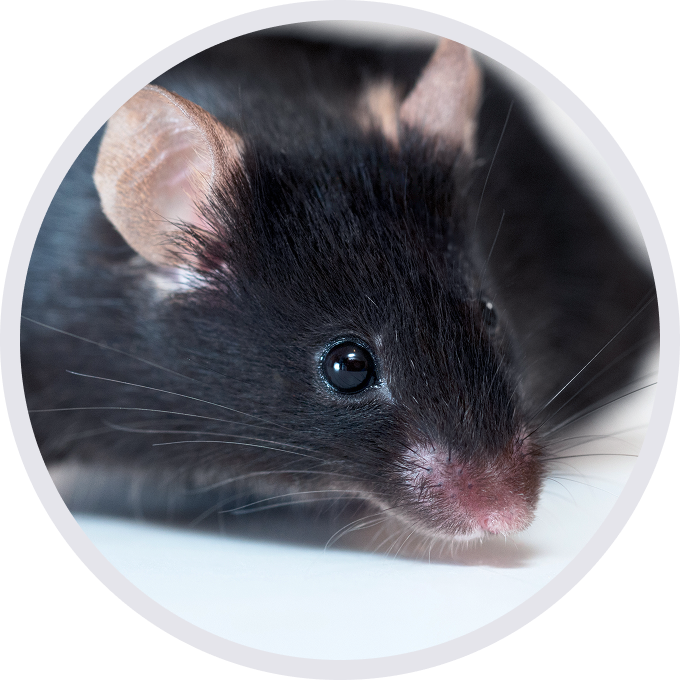
C57BL/6-Fcgrttm1(FCGRT)Bcgen Rag2tm1Bcgen/Bcgen • 113288

| Product name | B-hFcRn, Rag2 KO mice |
|---|---|
| Catalog number | 113288 |
| Strain name | C57BL/6-Fcgrttm1(FCGRT)Bcgen Rag2tm1Bcgen/Bcgen |
| Strain background | C57BL/6 |
| NCBI gene ID | 2217,5897,14132,19374 (Mouse) |
| Aliases | FCRN; alpha-chain; RAG-2; Fc; FcRn; Rag; Rag-2 |
Gene targeting strategy for B-hFcRn, Rag2 KO mice.
B-hFcRn mice (110001): The CDS that encodes full-length human FCGRT, followed by the mouse 3’UTR-STOP, is inserted right after the mouse Fcgrt ATG to replace the exons 2-4 of the mouse Fcgrt gene. The FcRn protein expression will be driven by the endogenous mouse Fcgrt promoter, while the mouse Fcgrt gene transcription and translation will be disrupted.
B-Rag2 KO mice (110809): The exon 3 and 3’UTR region were knocked out in B-Rag2 KO mice, resulting in a disruption of the Rag2 gene.
B-hFcRn, Rag2 KO mice were obtained by mating B-hFcRn mice (110001) and B-Rag2 KO mice (110809).

Western blot analysis of FcRn protein expression in homozygous B-hFcRn, Rag2 KO mice. Spleen, lung tissue lysates were collected from wild-type C57BL/6N mice (+/+), homozygous B-hFcRn mice (H/H), and homozygous B-hFcRn, Rag2 KO mice (H/H, -/-), and then analyzed by western blot with species-specific anti-FcRn antibody (anti-mouse FcRn: RD, AF6775; anti-human FcRn: NOVUS, NBP1-89128). 40 μg total proteins were loaded for western blotting analysis. Mouse FcRn was only detected in wild-type C57BL/6N mice. Human FcRn was detected in spleen and lung of B-hFcRn mice and B-hFcRn, Rag2 KO mice.

Frequency of leukocyte subpopulations in spleen by flow cytometry. Splenocytes were isolated from wild-type C57BL/6N mice (female, n=3, 9-week-old) and homozygous B-hFcRn, Rag2 KO mice (female, n=3, 9-week-old). A. Flow cytometry analysis of the splenocytes was performed to assess the frequency of leukocyte subpopulations. B. Frequency of T cell subpopulations. NK cells, DCs, neutrophils, monocytes, and macrophages were increased in homozygous mice. T cells, B cells, CD4+ T cells, CD8+ T cells, and Treg cells were undetectable in homozygous mice. Values are expressed as mean ± SEM. Significance was determined by a two-way ANOVA test. *P < 0.05, **P < 0.01, ***P < 0.001, ****P < 0.0001.

Frequency of leukocyte subpopulations in blood by flow cytometry. Blood were isolated from wild-type C57BL/6N mice (female, n=3, 9-week-old) and homozygous B-hFcRn, Rag2 KO mice (female, n=3, 9-week-old). A. Flow cytometry analysis of the blood was performed to assess the frequency of leukocyte subpopulations. B. Frequency of T cell subpopulations. NK cells, DCs, neutrophils, monocytes, and macrophages were increased in homozygous mice. T cells, B cells, CD4+ T cells, CD8+ T cells, and Treg cells were undetectable in homozygous mice. Values are expressed as mean ± SEM. Significance was determined by a two-way ANOVA test. *P < 0.05, **P < 0.01, ***P < 0.001, ****P < 0.0001.

Frequency of leukocyte subpopulations in the thymus by flow cytometry. Thymus cells were isolated from wild-type C57BL/6N mice (female, n=3, 9-week-old) and homozygous B-hFcRn, Rag2 KO mice (Female, n=3, 9-week-old). A. Flow cytometry analysis of the thymus cells was performed to assess the frequency of T cell subpopulations. CD4+ CD8+ T cells, CD4+ T cells, CD8+ T cells, and Treg cells were undetectable in homozygous mice. Values are expressed as mean ± SEM. Significance was determined by a two-way ANOVA test. *P < 0.05, **P < 0.01, ***P < 0.001, ****P < 0.0001.